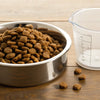How Much Food to Give a Dog by Weight: A Comprehensive Guide for Pet Owners
- Houndsy
Table of Contents
- Introduction
- Understanding Your Dog’s Nutritional Needs
- The Importance of Quality Over Quantity
- How the Houndsy Kibble Dispenser Enhances Feeding
- Conclusion
Introduction
Did you know that nearly 59% of dogs in the United States are overweight or obese? This startling statistic underscores the importance of understanding how much food to give a dog by weight. As responsible pet owners, we all want the best for our furry friends, including proper nutrition that supports their health and longevity. However, determining the right portion can often feel overwhelming, especially with the myriad of factors influencing a dog’s dietary needs.
In this blog post, we will dive deep into the fundamentals of dog nutrition, focusing on how to calculate the appropriate amount of food based on your dog's weight. We will explore key factors that influence feeding amounts, including age, size, activity level, and health status. By the end of this article, you will have a clear understanding of how to tailor your dog’s diet to their specific needs, ensuring they lead a happy, healthy life.
Additionally, we will touch upon the significance of our flagship product, the Houndsy Kibble Dispenser, designed to make the feeding process convenient, consistent, and visually appealing—aligning perfectly with our mission to elevate the dog-feeding experience. Let’s embark on this journey to better understand our canine companions’ nutritional needs!
Understanding Your Dog’s Nutritional Needs
1. The Basics of Dog Nutrition
Before we can determine how much food to give a dog, it's essential to grasp the fundamental components of a dog's diet. Dogs require a balanced mix of proteins, fats, carbohydrates, vitamins, and minerals. The specific proportions of these nutrients can vary based on several factors, including:
- Age: Puppies require more energy and nutrients for growth than adult dogs. In contrast, senior dogs may need fewer calories.
- Weight: Heavier dogs generally need more food, but the type and quality of food also matter.
- Activity Level: Active dogs have higher calorie needs compared to their sedentary counterparts.
- Health Status: Dogs with certain health conditions may require specialized diets.
2. Factors Influencing Portion Sizes
To accurately assess how much food to provide, we need to consider several factors:
- Age: Puppies, adults, and senior dogs each have unique dietary requirements. For instance, while puppies may need to be fed three to four times daily, adult dogs typically do well with two meals a day.
- Size and Breed: Larger breeds require more food than smaller breeds. For example, a Great Dane will consume significantly more than a Chihuahua.
- Body Condition Score (BCS): This scoring system evaluates a dog’s body fat and muscle condition, helping you determine if your dog is underweight, at an ideal weight, or overweight.
- Reproductive Status: Spayed or neutered dogs generally have lower calorie requirements than intact dogs.
3. The Role of Caloric Needs
Instead of measuring food strictly by volume (like cups), assessing your dog’s caloric needs provides a more accurate approach. The caloric requirement usually considers the dog's resting energy requirement (RER), which can be calculated using the formula:
[ RER = 70 \times (body weight in kg)^{0.75} ]
This formula provides a baseline for how many calories your dog should consume daily. From there, adjustments can be made based on activity level and life stage.
4. Feeding Guidelines
Now that we understand the importance of various factors, let’s look at general feeding guidelines based on weight and life stage.
Adult Dog Feeding Chart
| Dog Weight (lbs) | Daily Food Amount (cups) |
|---|---|
| 3-6 | ⅓ to ½ |
| 10-20 | ¾ to 1 ⅓ |
| 30-50 | 1 ¾ to 2 ⅔ |
| 60-100 | 3 to 4 ½ |
| Over 100 | 4 ½ plus ¼ cup for every additional 10 lbs |
Puppy Feeding Chart
Puppies generally require more food relative to their size due to their growth needs. Here’s a simple chart based on weight:
| Puppy Weight (lbs) | Daily Food Amount (cups) |
|---|---|
| 3-12 | ½ to 1 |
| 13-20 | ½ to 1 ¼ |
| 21-50 | 1 to 2 ¾ |
| 51-75 | 1 ½ to 4 |
| 76-100 | 2 to 5 |
Note: Feeding amounts may vary based on the specific caloric density of the food you are using.
5. Adjusting for Special Needs
If your dog has health issues or is overweight, consult your veterinarian to determine a tailored feeding plan. Adjustments in the amount and type of food may be necessary to ensure their health and well-being.
The Importance of Quality Over Quantity
While knowing the correct amount of food is crucial, the quality of that food is equally, if not more, important. High-quality dog food contains essential nutrients that support your dog’s overall health. Here are a few tips for selecting quality food:
- Read Ingredients: Look for whole food ingredients, such as meat, vegetables, and grains.
- Avoid Fillers: Steer clear of foods with excessive fillers or artificial additives.
- Check Nutritional Information: Ensure the food meets AAFCO standards for nutritional adequacy.
How the Houndsy Kibble Dispenser Enhances Feeding
At Houndsy, we are committed to making the dog feeding experience as seamless and enjoyable as possible. Our Houndsy Kibble Dispenser combines functionality and design excellence, allowing pet owners to manage their dogs' feeding routines with ease. Below are some features that align with our mission:
- Convenience: The crank mechanism allows for easy dispensing without bending down, making it accessible for pet parents of all ages.
- Perfect Portion Control: Our dispenser ensures consistent portion sizes, helping to prevent overfeeding and maintain your dog’s ideal weight.
- Stylish Design: With a mid-century modern aesthetic, the Houndsy Kibble Dispenser fits seamlessly into any home décor, elevating the feeding ritual to an art form.
Explore the Houndsy Kibble Dispenser here and experience the difference for yourself!
Conclusion
Understanding how much food to give a dog by weight is a crucial aspect of responsible pet ownership. By considering factors such as age, activity level, and health status, we can ensure our furry friends receive the right nutrients in the right amounts. Remember, it’s not just about feeding; it’s about nourishing our pets with quality food that supports their health and happiness.
As we’ve discussed, the Houndsy Kibble Dispenser can play a vital role in enhancing your dog’s feeding experience, making it convenient and beautiful. By investing in tools that promote better feeding habits, we are investing in the well-being of our beloved pets.
FAQ
1. How can I determine my dog's ideal weight? Consult your veterinarian for a body condition score evaluation, which can help you understand your dog’s ideal weight based on their breed and age.
2. What if my dog is overweight? If your dog is overweight, consult your veterinarian to create a weight loss plan that may include adjustments in diet and exercise.
3. Can I feed my dog homemade food? Yes, but it’s essential to ensure that the food meets your dog’s nutritional requirements. Consulting with a veterinary nutritionist is recommended.
4. How often should I feed my dog? Most adult dogs do well with two meals a day, while puppies may need three to four meals depending on their age.
5. Why is portion control important? Proper portion control helps prevent obesity and its related health issues, ensuring your dog remains healthy and active.
By keeping these insights in mind and utilizing tools like the Houndsy Kibble Dispenser, we can make feeding time a positive experience for both us and our canine companions. Let’s ensure our dogs receive the love, care, and nutrition they deserve!












